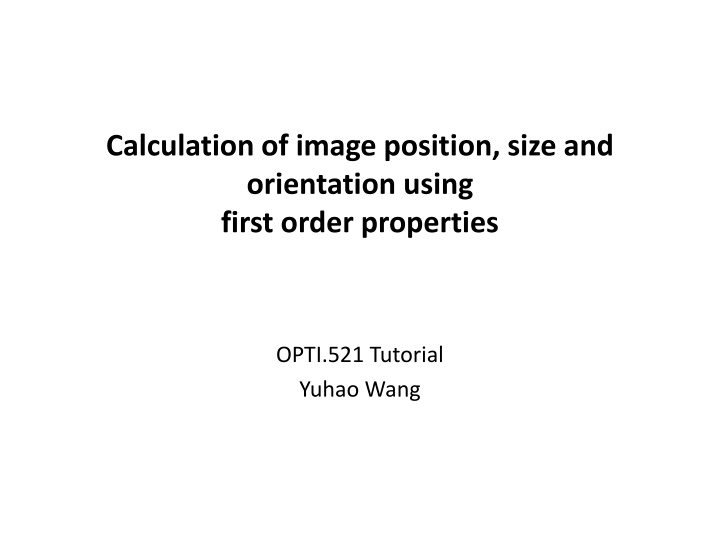
Calculation of Image Position, Size, and Orientation Using First Order Properties
"Learn about determining image characteristics through first-order properties in optics. Explore topics such as cardinal points, afocal systems, paraxial ray tracing, Scheimpflug principle, and more. Understand the impact of optical element tilt and the use of prisms in optical systems."
Download Presentation

Please find below an Image/Link to download the presentation.
The content on the website is provided AS IS for your information and personal use only. It may not be sold, licensed, or shared on other websites without obtaining consent from the author. If you encounter any issues during the download, it is possible that the publisher has removed the file from their server.
You are allowed to download the files provided on this website for personal or commercial use, subject to the condition that they are used lawfully. All files are the property of their respective owners.
The content on the website is provided AS IS for your information and personal use only. It may not be sold, licensed, or shared on other websites without obtaining consent from the author.
E N D
Presentation Transcript
Calculation of image position, size and orientation using first order properties OPTI.521 Tutorial Yuhao Wang
First order properties Imaging with a thin lens
Lens motion Lateral motion
Tilt of optical element For lens, no significant effect if tilt the lens about its center For mirror, the image will tilt 2 if you tilt the mirror by Lens is sensitive to decenter, mirror is sensitive to tilt.
Prisms Prisms fold the optical path, correct the image parity, and deviate light Prism systems can be considered systems of plane mirrors.
Applications Reflex prism (3 R) a pentaprism with an added roof mirror. Used in single lens reflex (SLR) camera viewfinders to provide an erect image of the proper parity.
Conclusion This tutorial discussed the methods to calculation image location, size and orientation using first order properties. Gaussian properties and paraxial raytrace are used. Especially, image orientation and parities are discussed in multiple prism systems. Also, some miscellaneous topics like Scheimpflug principle, lens motion and effects of plane parallel plate are also discussed.
Reference [1] John E. Greivenkamp Field Guide to Geometrical Optics SPIE [2] Prof. Jim Burge, class notes and lectures of Introductory opto-mechanical engineering , Fall 2010 [3] Prof. John Greivenkamp, class notes and lectures of Optical Design and Instrumentation I , Fall 2009 [4] Wikipedia, webpage http://en.wikipedia.org/wiki/Scheimpflug_principle






















